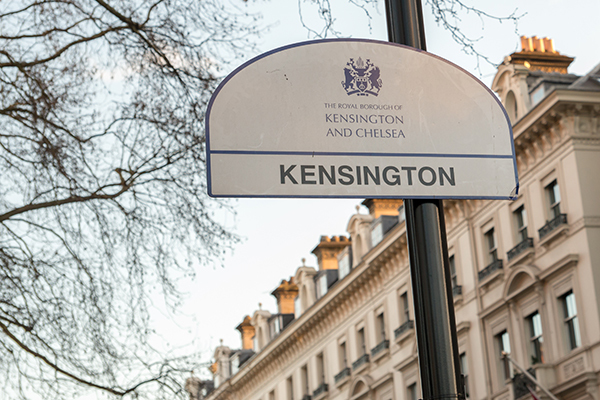You are viewing 1 of your 1 free articles
A critical eye: interview with Grenfell council’s deputy leader
Kensington and Chelsea London Borough Council has just published a discussion paper about the future of housing in the borough. Deputy leader Kim Taylor-Smith spoke to Martin Hilditch about its plans to win back people’s trust – and why he thinks some housing associations are immoral. Photography by Peter Searle
Kim Taylor-Smith became deputy leader of Kensington and Chelsea London Borough Council when his predecessor resigned weeks after the Grenfell Tower fire.
Together with Elizabeth Campbell, who took over as council leader after former leader Nicholas Paget-Brown stepped down following the tragedy, he has been the public face of the council’s response.
Fifteen months on, Inside Housing meets with Mr Taylor-Smith to talk about the next stage of that response.
The council published a discussion paper this week that Mr Taylor-Smith wants to “kick off debate and discussion” about the future of housing in the borough.
It sets out ambitions to build 300 new homes on council land by 2022 and to create a residents’ charter, and takes a swipe at the actions of both housing associations and private developers.
In his foreword to the paper, Mr Taylor-Smith says that the council has been forced to look with a “critical eye” at its housing provision after Grenfell and also after the council took back management of its stock from the Kensington and Chelsea Tenant Management Organisation (KCTMO) earlier this year.
KCTMO was the organisation that managed the council’s homes at the time of the fire, which killed 72 people.
Inside Housing met with Mr Taylor-Smith to find out what the discussion paper reveals about the council’s plans. We also wanted to find out quite how “critical” its eye has been when it comes to its housing provision – and what analysis has emerged as a result.
Let’s start with that criticism of some housing associations behaving “immorally” – strong words from a council that has had similar charges levelled at it since Grenfell Tower.
Mr Taylor-Smith starts off cautiously, saying: “I’ve got to be careful – I don’t want to give the impression I’m going to bash housing associations, because they are a really important partnership for us.” He also acknowledges that the way new housing is financed “has created challenges for associations when it comes to developing and they end up having to do mixed tenure”.
Nonetheless, he feels some associations “have got incredibly large balance sheets with lots and lots of cash, and I do not believe that they are fulfilling their basic function”.
"I don’t want to give the impression I’m going to bash housing associations, because they are a really important partnership for us.”
Websites for some prominent players only mention the word “housing association on a drop-down menu and the websites talk about being housing development companies”. A drift of focus from providing social benefit to generating profits “is something that is a big concern for us”, he says.
The discussion paper stops short of naming names. However, Mr Taylor-Smith does not.
He is specifically concerned about England’s biggest housing association, Clarion, which plans to redevelop the borough’s Sutton Estate. Built early in the 20th century with money from philanthropist William Sutton, the estate had 383 social homes, many of which could be lost permanently – the council rejected Clarion’s plans in 2016 over a “net loss of social rented housing”.
“If you look at the money Clarion have and the way that they are proposing to knock down and redevelop that estate with the loss of social housing units, I just think that morally is just wrong,” Mr Taylor-Smith says. “It is completely wrong. It is a very grand old building, probably one of the first social estates in London, and William Sutton would be turning in his grave.”
“If you look at the money Clarion have and the way that they are proposing to knock down and redevelop that estate with the loss of social housing units, I just think that morally is just wrong”
A spokesperson for Clarion says “there is absolutely no truth” to the allegation it has behaved immorally. When asked to clarify how many social homes would be lost under its plans, he adds that as the secretary of state has been called in, the group cannot comment on the numbers.
Mr Taylor-Smith would like to take further action in this area if possible. Early thought was given to whether it may be possible to use compulsory purchase orders to take over empty properties, such as those on the Sutton Estate, and the council has written to the government to request changes to legislation to make it easier to use empty dwelling management orders.
He says he would like to go to Clarion and say: “Why don’t we take your blocks A to D, which is 164 units, that have been lying empty for the last two years and give us a management contract to manage those and invest in terms of making those habitable?”
This isn’t a plan that looks like it has legs, however. A spokesperson for the Ministry of Housing, Communities and Local Government tells Inside Housing that it has no plans to change the rules.
The use of the word ‘immoral’ to describe actions that result in a loss of social housing in the borough opens the door for some interesting follow-up questions about policies that have a similar impact.
What, for example, does Mr Taylor-Smith, a Conservative councillor, think about the Right to Buy? That policy is leading to an erosion of council housing in the borough, so does Mr Taylor-Smith think the policy – or the way it is implemented – is immoral, too?
“That is one that I am just going to duck,” Mr Taylor-Smith states. “I think that is a wider conversation that I need to have with my colleagues, because some of my suggestions are already… one of the people now is referring to me as Comrade Kim. It is a very complex issue and you have outlined the complexity and I just acknowledge that.”
What about the council itself? Does the discussion paper’s statement that the council will “press for affordable provision” – at least 35% of housing schemes – and require the publication of viability assessments suggest that it previously did not push as hard as it could.
Ideas in the discussion paper
- Borough-wide conversation to capture how residents want homes to be managed and how repairs should be done and by whom
- Two-way residents’ charter to set out the council’s duty to residents and residents’ duty to neighbours and their homes
- Annual tenant visits focused on their health and wellbeing
- Plans to build 300 affordable homes on council land by 2022, subsidised by building 300 more for sale or rent on the open market. There were 23 net affordable completions in 2016/17
- Pushing harder to deliver 35% affordable on sites – with the council possibly making contributions to make this possible
- Joint management standards with housing associations to ensure all tenants live in well-maintained homes
“I really don’t want to go into how things were done in the past,” Mr Taylor-Smith states. “It is my watch now. I just want to be judged on what I am doing. What I will say is that I started from a very low base.”
"I just want to be judged on what I am doing. What I will say is that I started from a very low base”
If the council is questioning housing associations’ ethics, what does its critical eye reveal about the morality of the council’s own historical approach?
Mr Taylor-Smith starts off by saying that it had run excellent services in a number of areas, including schools, adult care and family services. Housing management was contracted out to KCTMO, but he adds: “That was not done well, absolutely not done well.”
When the council took back control of the stock in March, there was a backlog of 5,000 repairs; by August, it had worked its way through the entire lot.
Shouldn’t the council have realised there was a problem well in advance of this? The residents were, after all, its own tenants.
“I have got to be a little bit careful on this one,” Mr Taylor-Smith says. “The KCTMO provided information to the residents in terms of performance – outstanding repairs and key performance indicators (KPIs). We had just accepted that the TMO…”
He breaks off, before settling on saying: “We identified a lot of issues.”
Is he hinting that what KCTMO told the council was different from the reality?
“I think we have got to be careful,” Mr Taylor-Smith adds. “Some of the KPIs were new ones that we would have put in. But, I mean what we did is we produced a very, very stark audit. It was not a pretty picture.”
Clearly, major problems won’t be overcome immediately. Mr Taylor-Smith’s frank summary is that: “We have gone from a position on 1 March of being absolutely crap to being crap.”
The council’s commitment is that it will allow residents to decide how their homes are managed in the future.
“We have gone from a position on 1 March of being absolutely crap to being crap”
But Mr Taylor-Smith says he is “unashamedly saying I would like to demonstrate that we are the best people” to manage the homes.
“One of the most important relationships between us and our council tenants is the home – and it should never be remote,” he adds, suggesting that direct management is the favoured option.
This relationship is a major focus of the discussion paper. That sets out plans including a two-way residents’ charter. This would outline the council’s duties and responsibilities to tenants and leaseholders and, in turn, residents’ duties to their neighbours and homes.
The paper suggests that there could be an annual visit to each person, to improve relationships with tenants. These would discuss “general health and wellbeing”.
Officers would “identify issues, including mental and physical well-being, that may require adaptation to ensure homes suit the resident’s needs”.
Of course, as Mr Taylor-Smith states, the council will be judged on its actions. In recent weeks, its approach to one group of tenants with significant mental health needs has drawn some criticism. These are tenants of low-rise accommodation near Grenfell Tower, 63 of whom have been living in temporary accommodation since the fire. The council has been charging them the same rent they paid for their council homes, but has said that any still living in temporary accommodation after 22 October will have to pay temporary accommodation rents, which are much higher.
What is Mr Taylor-Smith’s response to the criticism that the council is putting pressure on a group of people that the council’s own documents acknowledge are finding it difficult to make decisions “because of trauma”?
He says it is complex to balance those residents’ needs with the £300,000 monthly cost of the temporary accommodation and a desire to rebuild the community on the Lancaster West Estate, where so many homes are sitting empty.
“When you sit down with somebody and explain it, even to the individual themselves, which is what I do, people are intelligent, they can understand,” he says.
Are some people facing impossible decisions, though? A council report earlier this month reveals that 15 of these tenants have been permanently rehoused – but several accepted overcrowded accommodation. About seven four-bedroom homes become available to let each year in the borough. Are some of the residents who feel they can’t return home facing impossible choices because of this shortage?
“In the main, they are not,” Mr Taylor-Smith states. “We do have some complex issues around larger properties and that is something we are addressing. Where we get commuted sums from the Community Infrastructure Levy, that is where we might spend on buying four-beds because four-beds is a bigger issue for us.”
The interview draws to a close and Mr Taylor-Smith heads off ahead of the official announcement breaking. The discussion paper is just the start of the conversation, of course. There are many more critical eyes to win over before it can hope to succeed.
















